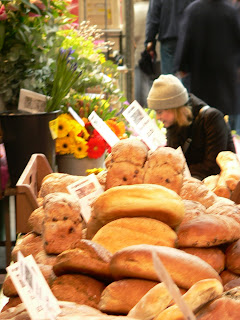My sister was in town this weekend. One of our favourite pastimes is cooking together. There’s a bit of an untold ritual to it – it begins with magazines and coffee. More specifically, food magazines (from the piles of Olive, Delicious, Good Food, Donna Hay, and Bon Appetit food magazines) and 3-6 cups of coffee, dependent on how inspired we are by what we see. This time, my sister tasked us with a challenge: Let’s only cook very difficult things! – the exclamation point reflecting her excitement. And so, we pored through the magazines, only stopping on recipes labelled “For the confident cook,” “A bit of effort,” or the more direct “Very Difficult.”
3.5 cups of coffee later, we’d settled on a menu for our Very Difficult Dinner Party:
Emmental gougéres (delicious mag, from The Skinny French Kitchen by Harry Eastwood)
Braised artichokes with lemon hazelnut praline, cherry tomato sauce and a chard, potato, and Puy lentil cake (delicious mag, from Irish chef Denis Cotter)
Roquefort soufflé on a salad of watercress, poached pear, and toasted pine nuts (really a combination of recipes we found online)
Poached salmon with pink grapefruit and basil sauce served with asparagus (Good Food, GordonRamsay)
Limoncello Meringue Pie (Olive, from Janine Ratcliffe)
Menu set, it was time for the next part of our ritual – Borough Market, via Gordon’s Wine Bar. After a leisurely pitstop in Gordon’s for a cheeky afternoon glass of cava, we walked along the southbank to Borough Market. There, we inhaled the atmosphere – full of tantalizing smells and drool-worthy food sightings – and successfully came away with loads of fruit and veg for our very difficult menu.
Our dinner party wasn’t until the next day, so we enjoyed a relaxing night in, trying our hand at creating some new recipes.
We embarked on cooking our menu at 3 o’clock the next day, telling guests to arrive anytime from 7pm – and I quickly learned just how inefficient I am in the kitchen, especially compared to my Cordon-Bleu-trained sister. Here’s how the day went:
3pm – START THE VERY DIFFICULT COOKING, 4 HOURS TIL GUESTS ARRIVE
Me: I’ll start on the artichoke! It says it takes 1.5 hours to make and 1 hour to cook.
Sister: I’ll make the limoncello tart!
base of the limoncello tart
the journey begins on the artichoke dish, later deemed my kitchen Everest.
4pm – TART CHILLING AND SALAD MADE, 3 HOURS TIL GUESTS ARRIVE
Sister: I’ve made the limoncello tart (except the meringue), poached pears, toasted pine nuts, made a salad dressing – how are you doing Steph?
Me: I’ve peeled one artichoke.
Sister: Do you need any help Steph?
Me: (grumble grumble grumble)
Sister: Do you want me to make the Emmental Gourgeres?
Me: (slightly defeated) Sure.
It's even prettier than the picture in the magazine!!
5pm – GOUGERES DOUGH MADE, TART COMPLETE, 2 HOURS TIL GUESTS ARRIVE
Sister: So gougeres dough is done, I’ll start on the soufflés!
Me: I've peeled three artichokes. And while I've started on some other parts of the artichoke dish, I've also started to lose the will to live.
Sister: That's nice Steph - keep up the good work!
Sister: That's nice Steph - keep up the good work!
Making the praline (with help from sis)
Lemon Hazelnut praline which gets blitzed in food processor and sprinkled onto artichoke dish)
(Puy Lentil and Potato mix to be wrapped in cavolo nero, instead of chard)
6pm – SOUFFLES PREP COMPLETE, 1 HOUR TIL GUESTS ARRIVE
Sister: So I’m done with the soufflé prep. I’ll cook the gougeres and start making the Hollandaise for the salmon if that’s okay? Do you think you can work on anything else besides the artichoke Steph?
Me: The artichoke is very demanding!! It needs lots of attention. I’m enslaved.
Sister: (Just stares at me)
Me: I’ll make the water to poach the salmon and cut up the grapefruit and basil.
6.45pm – I text friends and ask them to be late – “we” are very behind on our very difficult menu
7pm – ARTICHOKES FINALLY IN OVEN ALONG WITH LENTIL CAKES, HOLLANDAISE IN PROGRESS, 30 MINUTES TIL FRIENDS ARRIVE
(yep, this is all I have to show for - thankfully it was very tasty)
(yummy roquefort souffle)
7.30pm – EVERYTHING IS FULLY PREPPED/COMPLETED FOR THE NIGHT! (NO THANKS TO ME) – GUESTS ARRIVE
So not quite as smooth as it might have been had I started a little earlier. Not only did it take me a whopping 4.5 hours to make artichokes, I also missed out on learning how to make the perfect Hollandaise (my sister didn’t even have to look at a recipe – she really sickens me sometimes). The poached salmon with grapefruit/basil hollandaise was excellent - and really simple if you're only in charge of poaching the salmon. Somehow I failed to get a picture of this one, but I'd do it again! The limoncello meringue pie was standout - that recipe has made it into my binder for future use.
Was it all delicious? YES! Would I make it all again – not on your life! … especially that artichoke (despite it being very tasty).












































